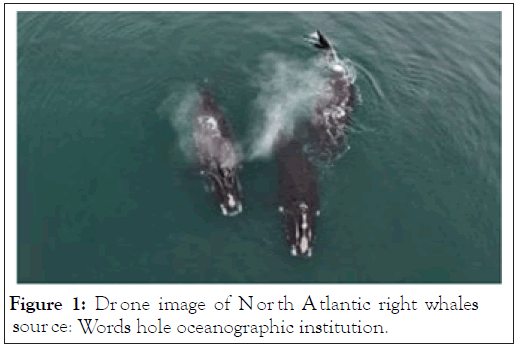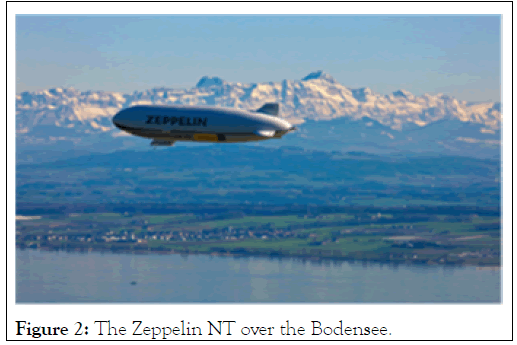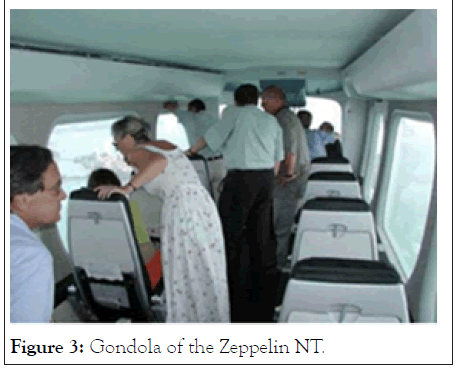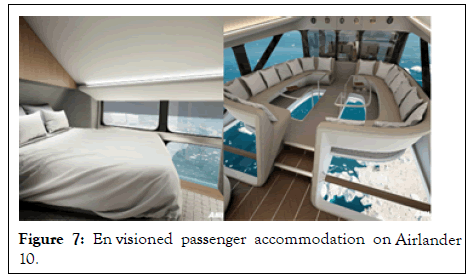Journal of Tourism & Hospitality
Open Access
ISSN: 2167-0269
+44 1300 500008
ISSN: 2167-0269
+44 1300 500008
Mini Review - (2021)
Ecotourism is a global growth industry and Canada is well-positioned to attract more tourists for these types of activities. However, remote locations are under-served with respect to access and inherently vulnerable. This presents significant difficulties for tourists who want to see Canada’s wildlife in their natural habitats. In addition, the use of transport to get close to wildlife for viewing opportunities can be stressful for the animals and may damage terrain. This article explores the use of passenger airships for ecotourism. Airships have been used a number of locations for tourism-related activities. Modern designs with electric propulsion make airships ideal for intrusive ecotourism operations.
Polar regions; Sustainability; Wildlife; Tourism; Hydrogen; Airships
Tourism is an important driver of economic growth, regional employment and income. Visitors to Canada contribute significantly to the economies of all provinces and territories. Prior to the COVID-19 global pandemic, travel and tourism generated one out of every ten jobs in Canada, contributed $95.9 billion in spending, and represented 2.1% of Canada’s Gross Domestic Product (GDP) in 2017 [1].
Ecotourism, with a focus on nature, remote experiences and sustainability, is one of the fastest growing segments of global tourism. However, this segment faces serious challenges. The first is the difficulty and cost for travelers to reach pristine, yet distant areas, like the Arctic. A second problem is how to allow groups to enjoy the wilderness areas and natural fauna, without destroying the environment by their very presence. This includes the potential damage to indigenous cultures that are recruited as guides, wait staff, etc.
Airships have had a difficult history, but are re-emerging with in the 21st century as a green technology that is ideally suited to serve the ecotourism industry. Airships could provide a means for travelers to experience Canada’s vast geography with minimal impact, using scenic, low-elevation flights to observe areas of unique biodiversity. Nature could be observed more accessibly, from comfy chairs and climate control, and without humans becoming prey to hungry mosquitoes or polar bears.
The ecotourism access challenge relates to transportation infrastructure gaps and the lack of regular passenger service to remote northern areas. Paved roads allow travel to the capitals of the Yukon and the Northwest Territories (NWT), but not to Nunavut, which has no road access to its territory. Outside the capitals, transportation service declines rapidly. Only 19 of the 33 communities of the NWT have year-round road access [2].
The capital cities of the Arctic are also accessible by scheduled jet plane services from southern Canada. From these airports, small airplanes and helicopters serve the more remote communities. Smaller European cruise vessels currently bring tourists through the Davis Strait and Baffin Bay in the eastern Arctic. In 2016, the Crystal Serenity was the first luxury cruise liner to navigate the Northwest Passage. Farther south, a passenger rail service from Winnipeg to Churchill, Manitoba, provides access for tourists to the ‘Polar Bear Capital of the World’.
The sustainability challenge for ecotourism is how to travel beyond the hotels or guest houses to visit the natural habitats and areas of interest, without alarming the local wildlife. The famous Tundra Buggies® at Churchill allow up to 40 tourists to see polar bears on their annual migration to the Hudson Bay shore. However, these tours are limited to an established tract and from mid-October to mid-November. Helicopter operators also provide polar bear tours, but their high cost per hour, limited capacity, and loud rotor noise make them less desirable than other forms of transport for ecotourism usage.
Many species are disturbed by human generated sounds, like marine propellers. Whale-watching boats in the St. Lawrence estuary and off the Atlantic and Pacific coasts need to observe strict distancing requirements from the whales in order to reduce stress for the animals. Using current technology, ecotourism may already be approaching its maximum limits for whale-watching (Figure 1).

Figure 1: Drone image of North Atlantic right whales source: Words hole oceanographic institution.
The opportunity for expansion lies with airship technology that can silently place nature lovers imperceptibly above pristine environments. An aerial platform can also provide a superior experience for ecotourism. As illustrated by the photographs taken by a drone, from above ecotourists would be able to see the entire whale and family members swimming below and with them.
Travel in an airship allows a unique perspective. Gliding slowly enough and close to the earth’s surface observer can obtain an intimate view of spectacular geographic features and wildlife in their natural habitats. Although airship-based tourism does exist, they have not focused on ecotourism per se. Moreover, the small size of the existing airships requires high ticket prices and corporate sponsorship to cover their costs.
Since 2001, the Zeppelin Company has provided tourist flights over the Lake Constance in Germany with spectacular view of the Alps [3]. The Zeppelin NT airship carries 12 passengers on half-hour and one-hour flights that operate from the Friedrichshafen airport. As seen in the photo of the gondola, passengers can stand up and look out large windows from this stable platform (Figures 2 and 3).

Figure 2: The Zeppelin NT over the Bodensee.

Figure 3: Gondola of the Zeppelin NT.
The Goodyear Tire & Rubber Company has provided airship rides in its blimps for over 60 years, but these trips are exclusively for corporate guests. In 2017, the last of the famous GZ-20 blimps operated by Goodyear, was retired. They continue to combine advertising and airship rides with a new fleet of three Zeppelin NTs which have replaced the original blimps.
Although Zeppelin and Goodyear have been operating small airships successfully for decades, others have found it difficult to operate a commercial tourist service profitably. Sky cruise Switzerland operated tourist flights between 2002 and 2007, with two Sky ship 600 blimps that can carry up to 13 passengers. They engaged the advertising market and provided security at the summer Olympics at Athens, but by 2010 they had ceased operations.
In Japan, the Nippon Airship Corporation began tourist flights with a Zeppelin NT in 2007. Even with high-ticket prices it became difficult to cover overhead costs with only a single airship. In 2010, they filed for bankruptcy. A similar fate confronted Airship Ventures, based out of Mountain View, California. They leased a Zeppelin NT to operate ‘flightseeing’ trips and aerial advertising along the US west coast for four years (2008-2012) [4]. They cited a lack of a corporate advertising sponsor as the reason for terminating the service.
Size clearly matters in the economics of airships. The Atlas LTA airship company, based in Israel, is proposing to build all-electric blimps for airship tourism [5]. The Atlas-11 airship is designed with cabins that can carry from 17 to 24 passengers. The service, which is proposed to begin in 2023, will feature flights with low noise and vibration, and large windows. The use of hydrogen fuel cell technology for propulsion enables these airships to operate with zero carbon emissions, which would be appreciated by the ecotourism market.
Ecotourism values extend beyond preserving natural wilderness spaces. Cultural icons and historic sites of global importance are also put at risk by excessive tourist numbers. For example, tourists are now prohibited from climbing the Mayan and Egyptian pyramids because of the repetitive damage that thousands of tourists have caused. Tourism operators at these locations now offer hot air balloon rides, but airships can handle larger numbers of passengers and could provide a safer and more stable alternative.
The Arctic region has a history of early exploration by airships, which was later followed by citizen-science polar research. In 1926, the Italian-built Norge was the first aircraft to reach the North Pole. The Norge was designed and piloted by Umberto Nobile, and sponsored by the Norwegian Air Association. The expedition included the famous explorer Roald Amundson, who had previously traveled overland to both the North and South Poles (Figures 4 and 5).

Figure 4: The Norge.

Figure 5: The Italia.
Two years later, Nobile returned to the Arctic with a second airship, the Italia. Unfortunately, this airship developed flight troubles and crashed on ice flows in a major storm. The Norge is the photo on the left, and the Italia is shown in the right, in diagrammatic form to illustrate the gas cells that filled the bulk of its semi- rigid structure and provided the required lift [6].
These flights spurred a further attempt to explore, photograph and travel in the Arctic regions. In the 1931, the Graf Zeppelin took a multi-national scientific expedition close to the North Pole to conduct experiments, collect meteorological data, and create a photographic survey of the geographical features of the region.
As the 100th anniversary of first airship journey to the North Pole approaches, an adventurous airship ecotourism passenger service is being organized by Ocean Sky, based in Sweden. They propose to take up to 16 passengers to the North Pole from Svalbard, using a Hybrid Air Vehicles (HAV) Airlander 10 airship. A true luxury expedition, these flights are expected to last 36 hours and cost $250,000 USD [7-9] (Figures 6 and 7).

Figure 6: Artist’s concept of Airlander 10 flying over the Arctic.

Figure 7: En visioned passenger accommodation on Airlander 10.
For most tourists, the Ocean Sky offering may seem as unattainable as the near space flights being offered by Sir Richard Branson and by Jeff Bezos. However, much larger airships have been built 85 years ago that could carry 65 passengers in comfort. The size of the airship makes little difference to natural world below, but could bring ticket prices down to earth, and expand the ecotourism market.
Visitors from around the globe have repeatedly demonstrated a sustained and growing interest in ecotourism. Travel in an airship allows a unique opportunity. Getting close enough to nature to watch it, without harmful disturbance has been almost impossible. Gliding slowly and quietly at 300 meters above the earth’s surface in an airship would provide an intimate observation of spectacular geographic features and wildlife in their natural habitats.
Ecotourism in northern Canada and the Arctic needs a reliable method of passenger transport in order to further develop these opportunities. An airship travel industry supporting the region could be the start to an entirely new period of growth and tourism development in Canada. Of course, the demand for ecotourism extends far beyond the Arctic. Imagine traveling over the tropical rain forests of the Amazon, watching herds of migrating animals on the African savanna, or observing pods of whales in the open marine environment. The ability to view wildlife from above, through expansive windows, while safely within a stable, vibrationless cabin, would provide the experience of a lifetime.
Citation: Prentice BE, Wilms J (2021) Sustainable Ecotourism and Airship Travel. J Tourism Hospi. S4: 004.
Received: 09-Jul-2021 Accepted: 23-Jul-2021 Published: 30-Jul-2021 , DOI: 10.35248/2167-0269.21.s4.004
Copyright: © 2021 Prentice BE, et al. This is an open-access article distributed under the terms of the Creative Commons Attribution License, which permits unrestricted use, distribution, and reproduction in any medium, provided the original author and source are credited.